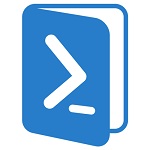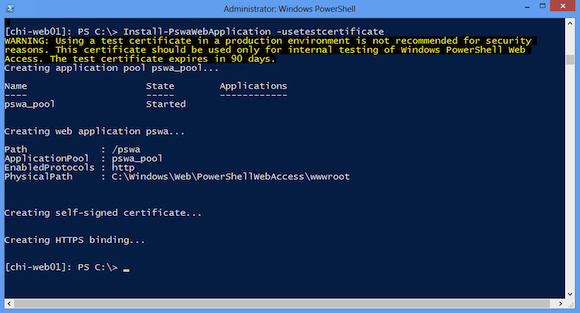PowerShell Web Access: Configuring
- Transfer
- Tutorial

Continuing Introducing Powershell Web Access (PSWA).
In a previous article, we talked about how to remotely install PowerShell Web Acess on a new web server from a Windows 8 client running RSAT. In this article, we will configure the gateway and configure authorization rules. The original article at petri.co.il can be found here . Interested parties are welcome to cat.
PSWA and gateway configuration
The commands required to configure the gateway can be run directly on the server, but I prefer to do everything remotely. Run the remote PowerShell session on the server (I work on a machine running Windows 8).
PS C:\> enter-pssession CHI-WEB01
(In our case, instead of CHI-WEB01 we indicate the name of our server - approx. Translator ).
Now I will configure the gateway using a self-signed test certificate. Then we will make the site use a valid certificate.
[chi-web01]: PS C:\> Install-PswaWebApplication –usetestcertificate
The above command assumes that I did not change the default site name (“Default Web Site”), as well as the application name (“pswa”). Figure 1 shows the result.

Configure authorization rules with PSWA
By default, no one has access to PowerShell Web Access. Authorization rules must be specified using the Add-PswaAuthorizationRule cmdlet . It must also be running on the web server, and I will take advantage of the current session. We specify the name of the user or his group to which you would like to grant access. It is also necessary to specify the names of computers that can be remotely accessed (you can use the name of the group that contains the computer accounts) and assign a configuration name.
The configuration is the name of the remote endpoint (remoting endpoint). The PSWA Gateway establish a remote connection to it. Use Get-PSSessionConfiguration to number these sessions.
PS C:\> invoke-command {get-pssessionconfiguration} -ComputerName chi-dc03
Figure 2 shows the available endpoints for the CHI-DC03 server.

Session configuration must be present on all computers included in the rule. I am going to create a test authorization rule using the Microsoft.PowerShell configuration. This is essentially the endpoint to which you are remotely accessing. You can also set the name of the rule, which I will do now.
[chi-web01]: PS C:\> Add-PswaAuthorizationRule -rulename "Test Rule 1" -computername chi-dc03 -username globomantics\jeff -configuration microsoft.powershell
“Test Rule 1” was chosen as the name of the rule. Of course, you can do any other.
Also pay attention to the format of the user name to which rights are granted. In this case, we use globomantics \ jeff.
If you try to do this on the new system, you will most likely get the following error:
Add-PswaAuthorizationRule : This command must be run by a user account with permissions to perform Active Directory queries.
If you run this command in an interactive session on the server (and not the remote one), then everything should work fine. The problem is the second relay (hop). The Add-PSwaAuthorizationRule cmdlet needs to communicate with a domain controller that is not allowed to be in PowerShell Remoting state by security rules. This second-hop limitation limitation can be overcome by activating CredSSP authentication. Attention : This should not be done “on the fly”, as there are safety implications, a preliminary study is required.
But in my case, since I want to use remote access, I will exit the remote session and activate CredSSP on my machine for the server CHI-WEB01.
PS C:\> Enable-WSManCredSSP -DelegateComputer chi-web01 -Role Client
Activated, now switch to the server features.
PS C:\> invoke-command {enable-wsmancredssp -Role Server -Force} -ComputerName chi-web01
Having done this, we re-launch the remote connection specifying CredSSP and my access settings.
PS C:\> enter-pssession chi-web01 -Authentication Credssp -Credential globomantics\jeff
When I run the authorization command, it works as shown in Figure 3.

I can also check the rule:
[chi-web01]: PS C:\> Get-PswaAuthorizationRule
Id RuleName User Destination ConfigurationName
-- -------- ---- ----------- -----------------
0 Test Rule 1 globomantics\jeff globomantics\chi... microsoft.powers...
You can add as many authorization rules as you like. You can access a machine with PowerShell v2 if remote access is enabled on it. For example, add a rule for a domain controller with PowerShell v2.
[chi-web01]: PS C:\> Add-PswaAuthorizationRule -rulename "Test Rule 2" -computername chi-dc02 -username globomantics\jeff -configuration microsoft.powershell –force
To remove a rule, use Remove-PwaAuthorizationRule . Refine the rule by id or rule object.
[chi-web01]: PS C:\> Remove-PswaAuthorizationRule -id 1 -whatif
What if: Performing operation "Remove-PswaAuthorizationRule" on Target "Rule 'Test Rule 2' (ID: 1)".
[chi-web01]: PS C:\> Get-PswaAuthorizationRule "test rule 2" | Remove-PswaAuthorizationRule –force –whatif
What if: Performing operation "Remove-PswaAuthorizationRule" on Target "Rule 'Test Rule 2' (ID: 1)".
What we described above can be done through the IIS manager. But I assume that if you decide to configure PowerShell Web Access, you are more comfortable working in PowerShell. Configuration cmdlets must be run on the web server where the PSWA application resides. The next article will cover testing and using PowerShell Web Access.
The end of the translation.
Deploying Windows PowerShell Web Access - an article on Technet
